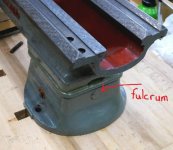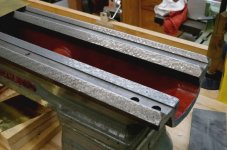I have this awful feeling that I have a really twisted 10K lathe.
I'm finally getting started on my 1965 vintage South Bend 10K. First step is measurement and planning. For measurement I set the bed on my woodworking bench and shimmed the headstock end of the until it was level (photo #1). The tailstock end has a leveling mechanism which I left loose so that it was resting on a single point (well, it is really resting on the 1/2" pin which is the fulcrum of the leveling mechanism) (see photo #2). For scraping the prisms the bed will be in a 45 degree carriage on my workbench so that I can scrape level at all times.


I shimmed the bed level, removed the shims, moved, repositioned, and re-leveled the bed several times and was able to get easily repeatable readings from the precision level across the top of the outer ways. I also measured the maximum wear to the ways (front way near the headstock) with a 3' straight edge and feeler gauges as about 0.004"



While the inner ways under the headstock were beautifully smooth and printed a very nice pattern with a 12" straight edge (photo #3), the rest of the inner and outer ways had been flaked by someone with altogether too much enthusiasm, and were quite rough with relatively few points of contact (photo #4). I leveled across the top of the ways at the headstock and then placed the level across the ways at the tailstock end of the bed. Surprise - the top of the front way was 0.004" lower than the top of the back way at the tailstock. At the middle of the bed the front way was 0.0025" lower. Since the bed was resting on three points, and was not bolted down or otherwise stressed, this would seem to indicate about 8 times as much twist as the allowable error (0.0005") indicated in South Bend Form 1351-10K (South Bend 10K accuracy report, available in the files section of the Yahoo SouthBend10K forum).
I lightly stoned the prism surfaces of the outer ways at each end of the bed and checked the level again using a set of SPI V-blocks (photo #5). At the headstock the front way was now 0.001" lower than the back way and at the tailstock was 0.005" lower - the same amount of twist as indicated when leveling across the tops of the ways. If this bed really does have 0.004" twist (in addition to wear), I will have to decide whether to take all the twist out at the tailstock end or to split the difference between both ends. Suggestions are welcome!!! I also realize that taking out the twist will mean truing the rear carriage gib way. What a mess...
Until I disassembled it, this lathe was mounted on cast iron legs with a horizontal countershaft hung behind the headstock on a 1/2" steel plate that was bolted between the bed and the cast iron legs. Even though there was a 3/8" x 1.5" diagonal steel strap from the rear cast iron legs to the bottom of the steel plate, I suspect that the countershaft was inadequately supported and probably caused the twist.
I should probably mention that I'm using a Polish level that is marked "0.0005 in/10 in". Differences were measured by first shimming the bed with the level across the ways at the headstock end and then shimming between the level and the ways at other locations until the bubble was centered. The level reads the same when reversed end for end, and my v-blocks also give the same readings when switched.
I'm finally getting started on my 1965 vintage South Bend 10K. First step is measurement and planning. For measurement I set the bed on my woodworking bench and shimmed the headstock end of the until it was level (photo #1). The tailstock end has a leveling mechanism which I left loose so that it was resting on a single point (well, it is really resting on the 1/2" pin which is the fulcrum of the leveling mechanism) (see photo #2). For scraping the prisms the bed will be in a 45 degree carriage on my workbench so that I can scrape level at all times.


I shimmed the bed level, removed the shims, moved, repositioned, and re-leveled the bed several times and was able to get easily repeatable readings from the precision level across the top of the outer ways. I also measured the maximum wear to the ways (front way near the headstock) with a 3' straight edge and feeler gauges as about 0.004"



While the inner ways under the headstock were beautifully smooth and printed a very nice pattern with a 12" straight edge (photo #3), the rest of the inner and outer ways had been flaked by someone with altogether too much enthusiasm, and were quite rough with relatively few points of contact (photo #4). I leveled across the top of the ways at the headstock and then placed the level across the ways at the tailstock end of the bed. Surprise - the top of the front way was 0.004" lower than the top of the back way at the tailstock. At the middle of the bed the front way was 0.0025" lower. Since the bed was resting on three points, and was not bolted down or otherwise stressed, this would seem to indicate about 8 times as much twist as the allowable error (0.0005") indicated in South Bend Form 1351-10K (South Bend 10K accuracy report, available in the files section of the Yahoo SouthBend10K forum).
I lightly stoned the prism surfaces of the outer ways at each end of the bed and checked the level again using a set of SPI V-blocks (photo #5). At the headstock the front way was now 0.001" lower than the back way and at the tailstock was 0.005" lower - the same amount of twist as indicated when leveling across the tops of the ways. If this bed really does have 0.004" twist (in addition to wear), I will have to decide whether to take all the twist out at the tailstock end or to split the difference between both ends. Suggestions are welcome!!! I also realize that taking out the twist will mean truing the rear carriage gib way. What a mess...
Until I disassembled it, this lathe was mounted on cast iron legs with a horizontal countershaft hung behind the headstock on a 1/2" steel plate that was bolted between the bed and the cast iron legs. Even though there was a 3/8" x 1.5" diagonal steel strap from the rear cast iron legs to the bottom of the steel plate, I suspect that the countershaft was inadequately supported and probably caused the twist.
I should probably mention that I'm using a Polish level that is marked "0.0005 in/10 in". Differences were measured by first shimming the bed with the level across the ways at the headstock end and then shimming between the level and the ways at other locations until the bubble was centered. The level reads the same when reversed end for end, and my v-blocks also give the same readings when switched.
Last edited:



 The other big factor is that the way small SB's wear with a "wear ridge". Using the tops which *might* be a legacy of how the lathe geometry was when new, if the lathe actually has enough wear to imply rebuilding; would not be a good reflection of the current way geometry seen by the saddle and TS.
The other big factor is that the way small SB's wear with a "wear ridge". Using the tops which *might* be a legacy of how the lathe geometry was when new, if the lathe actually has enough wear to imply rebuilding; would not be a good reflection of the current way geometry seen by the saddle and TS.  .
.

